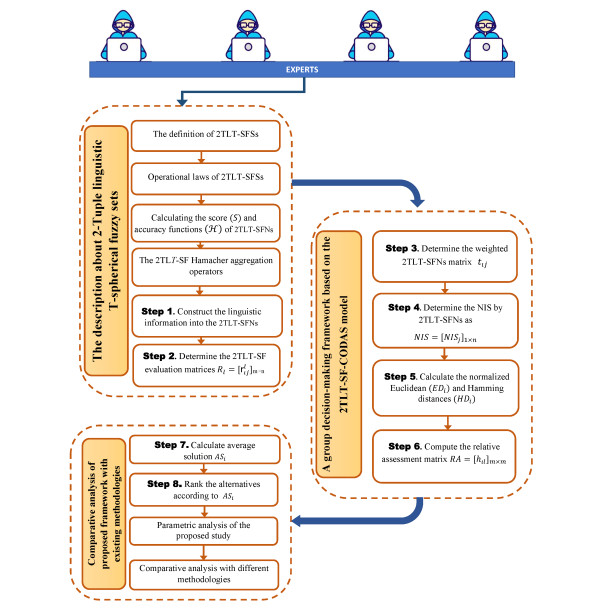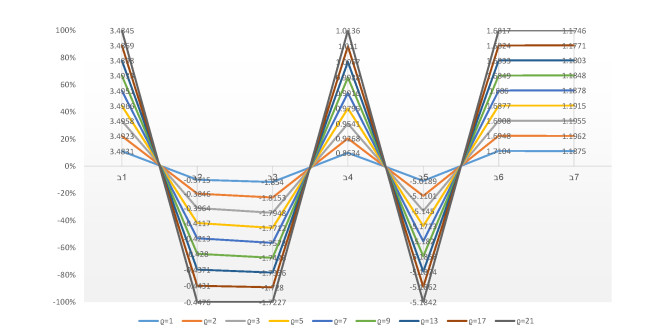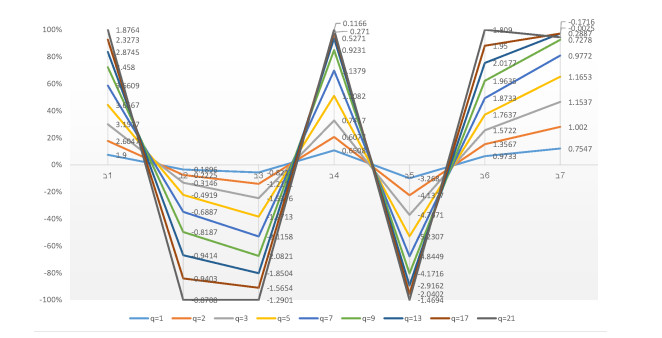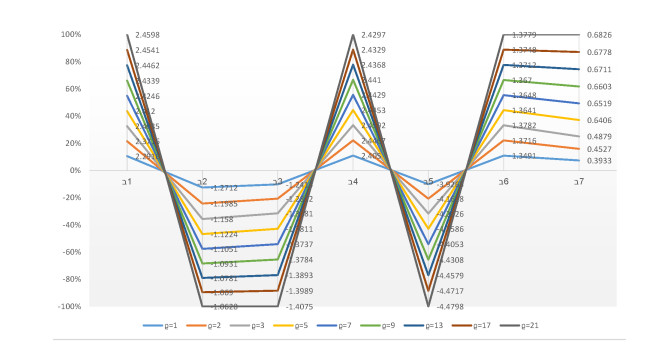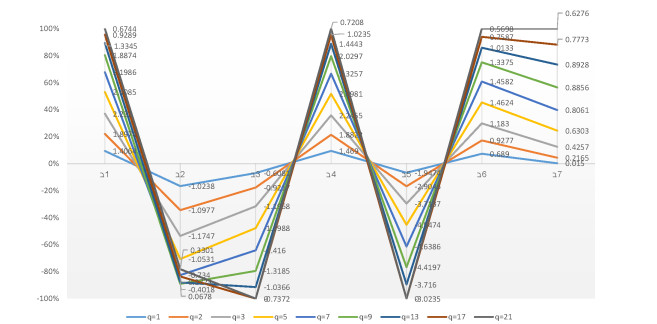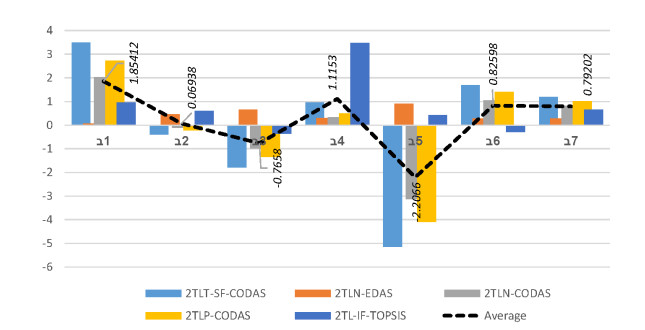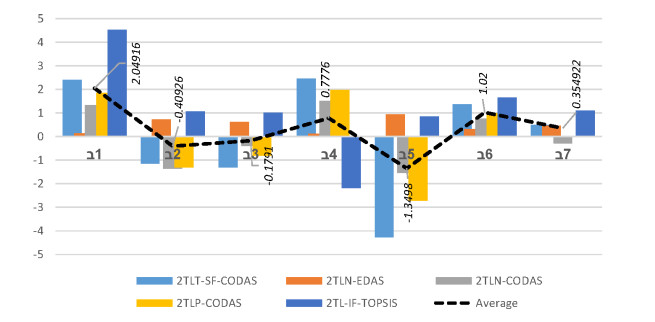1.
Introduction
Fixed point theory is concerned with some properties which ensure that a self map M defined on a set B admits at least one fixed point. By fixed point of M, we mean a point w∈B which solves an operator equation w=Mw, known as fixed point equation. Now, let F(M)={w∈B:w=Mw} stand for the set of all fixed points of M. The theory of fixed point plays significant role in finding the solutions of problems which arise in different branches of mathematical analysis. For some years now, the advancement of fixed point theory in metric spaces has captured considerable interests from many authors as a result of its applications in many fields such variational inequality, approximation theory and optimization theory.
Banach Contraction principle still remains one of the fundamental theorems in analysis. It states that if (B,d) is a complete metric space and M:B→B fulfills
for all g,h∈B with e∈[0,1), then there exists a unique fixed point of M.
Mappings satisfying (1.1) are known as contraction mappings. In 2003, Berinde [10] introduced the class of weak contraction mappings in metric space. This class of mappings are also called almost contraction. He proved that this class of mappings is a superclass of the class of Zamfirescu mapping [53] which properly contains the classes of contraction, Kannan[23] and Chatterjea[11] mappings.
Definition 1.1. A map M:B→B is called almost contraction if some constants e∈(0,1] and L≥0 exists such that
In [10], Berinde showed that every almost contraction mapping M has a unique fixed point in a complete metric space (B,d). The map M is termed nonexpansive if
for all g,h∈B. It is known as quasi-nonexpansive mapping if F(M)≠∅ and
for all g∈B and w∈F(M). Due to the numerous applications of nonexpansive mappings in mathematics and other related fields, in recent years, their extensions and generalizations in many directions have been studied by different authors, see [7,40,41,42,44].
In 2008, Suzuki [44] studied a class of mapping called the generalized nonexpasive mappings (or mappings satisfying condition (C). The author studied the existence and convergence analysis of mappings satisfying condition (C).
Definition 1.2. A map M:B→B is said to satisfy condition (C) if
In 2011, Garchía-Falset et al. [20] introduced a general class of nonexpansive mappings as follows:
Definition 1.3. A mapping M:B→B is said to satisfy condition Eμ, if there exists μ≥1 such that
for all f,h∈B. Now, M is said satisfy the condition E whenever M satisfies the condition Eμ for some μ≥1.
Remark 1.4. As shown in [40], the classes of generalized α-nonexpansive mappings [42], Reich-Suzuki nonexpansive mappings [41], Suzuki generalized nonexpansive mappings [44], generalized α-Reich-Suzuki nonexpansive mapping [40] are properly included in the class of mappings satisfying (1.6).
The celebrated Banach contraction principle works with Picard iteration process. This principle has some limitations when higher mappings are considered. To get a better rate of convergence and overcome these limitations, several authors have studied different iteration processes. Some of these prominent iteration processes include: Mann [31], Ishikawa [26], Noor [32], S [3], Abbas [1], Thakur [46], Picard-S [22], M [48] iteration processes etc. In [3], the authors showed that S-iterative scheme converges at the same rate as that of Picard iterative algorithm and faster than Mann iteration process. In [1], it is shown that Abbas iteration method converges faster than Picard, Mann [31] and S-iteration [3] processes. In 2016, Thakur et al. [46] defined a new iterative process. It was shown by the authors that their method enjoys a better speed of convergence than Mann [31], Ishikawa [26], Noor [32], S [3] and Abass [1] iteration processes. In 2021, the JK iteration process was constructed by Ahmad et al. [4] for mappings satisfying condition (C). In [4,5], the authors showed that JK iteration process converges faster than Mann [31], Ishikawa [26], Noor [32], S [3], Abbas [1] and Thakur [46] iteration processes for mappings satisfying condition (C) and generalized α-nonexpansive mappings, respectively.
Recently, the following four steps iteration process known as the AH iteration process was introduced by Ofem et al. [33] in Banach spaces.
where {mk} and {δk} are sequences in (0,1). It was analytically shown in [33] that AH iterative algorithm (1.7) converges faster than JK iteration process [4] for contractive-like mappings. Furthermore, they showed numerically that AH iteration process (1.7) converges faster than several existing iteration processes for contractive–like mappings and Reich-Suzuki nonexpansive mappings, respectively.
Motivated by the above results, in this article, we construct the hyperbolic space version AH iteration process (3.1). Furthermore, we prove that the modified iteration process is data dependent for almost contraction mappings. We study several strong and △-convergence analysis of AH iterative scheme for mappings enriched with condition (E). Some numerical examples of the mappings enriched with condition (E) are provided to show the efficiency of our method over some existing methods. Finally, we apply our main results in solving nonlinear integral equation with two delays. Since hyperbolic spaces are more general than Banach spaces and by Remark 3.5 the class of mappings enriched with condition (E) is a super-class of those considered in Ahmad et al. [4,5] and Ofem et al. [33], it follows that our results will generalize and extend the results of Ahmad [4,5], Ofem et al. [33] and so many other existing results of well known authors.
2.
Preliminaries
Throughout this paper, we will let N denote the set of natural numbers, R the set of real numbers and C the set of complex numbers. Any given space that is endowed with some convexity structure is an important tool for solving the operator equation w=Mw. Since every Banach space is a vector space, it follows that a Banach space naturally inherits the convexity structure. On the other hand, metric spaces do not naturally enjoy this convex structure.
In [45], Takahashi developed the concept convex metric spaces and further investigated the fixed points of certain mappings in the setting of such spaces. It is well known that convex metric spaces contains all normed spaces as well as their convex subsets. But there are many examples of convex metric spaces which are not embedded in any normed space [45]. For some decades now, many authors have been introduced convex structures in metric spaces. The following W-hyperbolic spaces was introduced by Kohlenbach [25]:
Definition 2.1. A W-hyperbolic space (M,d,W) is a metric space (B,d) together with a convexity mapping W:B2×[0,1]→B satisfying the following properties:
(1) d(q,W(f,h,α))≤(1−α)d(q,f)+αd(q,h)
(2) d(W(f,h,α),W(f,h,β))=|α−β|d(f,h)
(3) W(f,h,α)=W(h,f,1−α)
(4) d(W(f,q,α),W(h,p,α))≤(1−α)d(f,h)+αd(q,p)
for all f,h,q,p∈B and α,β∈[0,1].
Suppose (B,d,W) fulfils only condition (1), then (M,d,W) becomes the convex metric space considered by Takahashi [45]. It is well known that every hyperbolic space is a convex metric space but converse is not generally true [14].
Normed linear space, CAT(0) spaces, the Hilbert ball and Busseman spaces are important examples of W-hyperbolic spaces [52].
A hyperbolic space (B,d,W) is known as uniformly convex [12], if for f,h,q∈B, ε∈(0,2] and r>0, it follows that a constant γ∈(0,1] exists with d(f,h)≤r, d(q,f)≤r, and d(h,q)≥εr. Then, we get
The modulus of uniform convexity [56], of B is a mapping ξ:(0,∞)×(0,2]→(0,1] which gives γ=ξ(r,ε) for any r>0 and ε∈(0,2]. We call ξ monotone if it decreases with r (for fixed ε), see [56].
A nonempty subset D of a hyperbolic space B is called convex if W(f,h,α)∈D for all f,h∈D and α∈[0,1]. If f,h∈B and α∈[0,1], then we denote W(f,h,α) by (1−α)f⊕αh. It is shown in [28] that any normed space (B,‖.‖) is a hyperbolic with (1−α)f⊕αh=(1−α)f+αh. This implies that the class of uniformly convex hyperbolic spaces is a natural generalization of the class of uniformly convex Banach spaces.
The concept of △-convergence in the setting of general metric space was introduced by Lim [30]. This concept of convergence was used by Kirk and Panyanak [24] to proved some results in CAT(0) spaces that are analogous of some Banach space results involving weak convergence. Furthermore, △-convergence results of the Picard, Mann[31] and Ishikawa[26] iteration processes in CAT(0) spaces were obtained by Dhompongsa and Panyanak [17]. In recent years, a number of articles concerning △-convergence have been published (see [2,19,21,27,34,52] and the references therein). To define △-convergence, we consider the following concept.
Let {fk} be a sequence which is bounded in a hyperbolic space B. A function r(.,{fk}):B→[0,∞) can be defined by
An asymptotic radius of a bounded sequence {fk} with respect to a nonempty subset D of B is denoted and defined by
An asymptotic center of a bounded sequence {fk} with respect to a nonempty subset D of B is denoted and defined by
Suppose the asymptotic radius of the asymptotic center are taken with respect B, then these are simply denoted by r({fk}) and A({fk}), respectively. Generally, A({fk}) may be empty or may even have infinitely many points, see [2,19,21,27,52,56].
The following lemmas, definitions and proposition will be useful in our main results.
Definition 2.2. [24] The sequence {fk} in B is said to be △-convergent to a point f∈B if f is the unique asymptotic center of every sub-sequence {fkj} of {fk}. For this, we write △−limk→∞fk=f and call f the △-limit of {fk}.
Lemma 2.3. [28] In a complete uniformly hyperbolic space B with monotone modulus of convexity ξ, it is well known that every bounded sequence {fk} has a unique asymptotic center with respect to every nonempty closed convex subset D of B.
Lemma 2.4. [29] Let (B,d,W) be a complete uniformly convex hyperbolic space with a monotone modulus of convexity ξ. Assume f∈B and {αk} is a sequence in [n,m] for some n,m∈(0,1). Suppose {fk} and {hk} are sequences in B such that lim supk→∞d(fk,f)≤a, lim supk→∞d(hk,f)≤a, limk→∞d(W(fk,hk,αk),f)=a for some a≥0, then
Lemma 2.5. [47] Let {ak} be a non–negative sequence for which one assumes that there exists an n0∈N such that, for all k≥n0,
is satisfied, where σk∈(0,1) for all k∈N, ∑∞k=0σk=∞ and gk≥0 ∀k∈N. Then the following holds:
Definition 2.6. [47] Let M, S:B→B. Then S is an approximate operator of M if for all ϵ>0, implies that d(Mf,Sf)≤ϵ holds for any f∈B.
Proposition 2.7. [20] Let M:B→B be a mapping which satisfies the condition (E) with F(M)≠∅, then M is quasi-nonexpansive.
Lemma 2.8. [43] Let D be a subset of (B,d,W). A mapping M:D→D is said to fulfil the condition (I) if a non-decreasing function ϱ:[0,∞)→[0,∞) exists with ϱ(0)=0 such that ϱ(r)>0 for any r∈(0,∞) we have d(f,Mf)≥ϱ(dist(f,F(M))) for all f∈D, where dist(f,F(M)) stands for the distance of f from F(M).
3.
Main results
Throughout the remaining part of this article, let (B,d,W) denote a complete uniformly convex hyperbolic space with a monotone modulus of convexity ξ and D be a nonempty closed convex subset of B.
In this section, we construct a modified form of AH iteration process (1.7) in hyperbolic spaces as follows:
where {mk}, {δk} are sequences in (0,1) and M is a mapping enriched with condition (E).
3.1. Data dependence result
In this section, we show the data dependence result of the iteration process (3.1) for almost contraction mappings. The following convergence theorem will be useful in obtaining the data dependence result.
Theorem 3.1. Let D be a nonempty, closed and convex subset of hyperbolic space B and M:D→D an almost contraction mapping. If the {fk} is the sequence defined by (3.1), then limk→∞fk=w, where w∈F(M).
Proof. Suppose that w∈F(M), from (1.2), (3.1) and Proposition 2.7, we have
Since δk∈(0,1), e∈[0,1) then 0<(1−(1−e)δk)≤1, thus (3.2) yields
Also, by (3.1) and (3.3), we have
Again, from (3.1) and (3.4), we get
Finally, using (3.1) and (3.5), we obtain
Inductively, we obtain
Since 0≤e<1, it follows that limk→∞fk=w.
Theorem 3.2. Let D, B and M be same as defined in Theorem 3.1. Let S an approximate operator of M and {fk} a sequence defined by (3.1). We define an iterative sequence {xk} for an almost contraction mapping M as follows:
where {mk} and {δk} are sequences in (0,1) satisfying 12≤mk, k∈N and ∑∞k=0mk=∞. If Mw=w and St=t such that xk→t as k→∞, then we have
where ϵ is a fixed number.
Proof. Using (1.2), (3.1) and (3.7), we have
Using (3.8)–(3.11), we have
Since {mk},{δk}∈(0,1) and e∈(0,1], then it follows that (e−1)≤0, [1−(1−e)mk]≤1 and [1−(1−e)δk]≤1. Therefore, (3.12) becomes
Since 12≤mk, ∀k≥1, then 1≤2mk, ∀k≥1. Thus, (3.13) becomes
Therefore,
where
ak+1=d(fk+1,xk+1),
σk=(1−e)mk∈(0,1),
and
gk=2L(1+e)d(fk,w)+2L(1+e)2d(qk,w)+2L(1+e)2d(vk,w)+mkL(1+e)d(hk,w)+11ϵ1−e≥0.
From Theorem 3.1, we have that limk→∞d(fk,w)=limk→∞d(hk,w)=limk→∞d(vk,w)=limk→∞d(qk,w)=0. By the hypothesis xk→t as k→∞ and using Lemma 2.5, we obtain
This completes the proof.
3.2. Strong and △-converge results
Now, we obtain the strong and △-convergence results of (3.1). To obtain these results, we will use the following lemmas.
Lemma 3.3. Let D and B be same as defined in Theorem 3.2 and Let M:D→D be a mapping enriched with the condition (E) such that F(M)≠∅. Suppose {fk} is the sequence iteratively generated by (3.1). Then, limk→∞d(fk,w) exists for all w∈F(M).
Proof. Assume that w∈F(M). From Proposition 2.7 and (3.1), we have
From (3.15) and (3.1), we have
Using (3.16) and (3.1), we get
Finally, (3.17) and (3.1), we obtain
This shows that {d(fk,w)} is a non-increasing sequence which is bounded below. Thus, limk→∞d(fk,w) exists for each w∈F(M).
Lemma 3.4. Let D, B and M be same as defined in Lemma 3.3. Let {fk} be the sequence defined by (3.1). Then, F(M)≠∅ if and only if {fk} is bounded and limk→∞d(fk,Mfk)=0.
Proof. Assume that {fk} is a bounded sequence with limk→∞d(fk,Mfk)=0. Let w∈A(D,{fk}). By the definition of asymptotic radius, we have
Since M is a mapping which satisfies condition (E), we obtain
Recalling the uniqueness of the asymptotic center of {fk}, we get Mw=w.
Conversely, let F(M)≠∅ and w∈F(M). Then by Lemma 3.3, limk→∞d(fk,w) exists. Now, suppose
From (3.15), (3.16) and (3.19), it follows that
Using Proposition 2.7, we get
By Lemma 3.3 and (3.1), one obtains
From (3.23), it follows that
Thus,
From (3.21) and (3.25), we get
Using (3.1) and (3.26), we have
So, from Lemma 2.4 we have
Now, we show the △-convergence result of the iteration process (3.1) for class of mappings enriched with condition (E).
Theorem 3.5. Let D, B and M be same as in Theorem 3.4 such that F(M)≠∅. Let {fk} is the sequence defined by (3.1). Then, {fk} △-converges to a fixed point of M.
Proof. By Lemma 3.3, we know that {fk} is a bounded sequence. It follows that {fk} has a △-convergent sub-sequence. Now, we show that every △-convergent sub-sequence of {fk} has a unique △-limit in F(M). Let y and z stand for the △-limits of the subsequences {fki} and {fkj} of {fk}, respectively. Recalling Lemma 2.3, we have A(D,{fki})={y} and A(D,{fkj})={z}. From Lemma 3.4, it follows that limi→∞d(fki,Mfki)=0 and limj→∞d(fkj,Mfkj)=0. We assume that w∈F(M). Again, we know that
Since M is a mapping which satisfies condition (E), we obtain
From the uniqueness of the asymptotic center, we know that Mw=w. Now, it is left to prove that w=z. We claim that w≠z and then from the uniqueness of asymptotic center, it follows that
which is clearly a contradiction. Therefore, y=z and hence, {fk} △-converges to a point of M.
Next, prove some strong convergence theorems as follows:
Theorem 3.6. Let D, B and M be same as in Theorem 3.4 such that F(M)≠∅. If {fk} is the sequence iteratively generated by (3.1). Then, {fk} converges strongly to a fixed point of M if and only if lim infk→∞dist(fk,F(M))=0, where dist(fk,F(M))=inf{d(fk,w):w∈F(M)}.
Proof. If lim infk→∞dist(fk,F(M))=0. By Lemma 3.3, it follows that lim infk→∞d(fk,F(M)). Thus,
From (3.28), a sub-sequence {fki} of {fk} exists with d(fki,ti)≤12i for all i≥1, where {ti} is a sequence in F(M). In view of Lemma 3.34, we obtain
Using (3.29), we have
It follows clearly that {fk} is a Cauchy sequence in D. Since D is a closed subset of B, limk→∞fk=z for some z∈D. Now, we prove that z is a fixed point of M. Since M is a mapping which satisfies condition (E), we have
Letting k→∞, then by Lemma 3.5 we have d(fk,Mfk)=0 and then it follows that d(z,Mz)=0. So, z is a fixed point of M. Thus, {fk} converges strongly to a point in F(M).
Theorem 3.7. Let D, B and M be same as in Theorem 3.4 such that F(M)≠∅. If {fk} is the sequence defined by (3.1) and M satisfies condition (I). Then, {fk} convergences strongly to an element in F(M).
Proof. Using Lemma 3.4, We have
Since M fulfills condition (I), we get d(Mfk,fk)≥ϱ(dist(fk,F(M))). From (3.32), we obtain
Again, since the function ϱ:[0,∞)→[0,∞) is non-decreasing such that ϱ(0)=0 and ϱ(r)>0 for all r∈(0,∞), then we have
Thus, all the conditions of Theorem 3.6 are performed. Hence, {fk} converges strongly to a fixed point of M.
Now, we give the following example to authenticate Theorem 3.7.
Example 3.8. Let B=R with the metric d(f,h)=|f−h| and D=[−3,∞). Define W:B2×[0,1]→B by W(f,h,α)=αf+(1−α)h for all f,h∈B and α∈[0,1]. Then (B,d,W) is a complete uniformly Hyperbolic space with monotone modulus of convexity and D is a nonempty closed convex subset of B. Let M:D→D be defined by
Since M is not continuous at f=13 and owing to the fact every nonexpansive mapping is continuous, then it implies that M is not a nonexpansive mapping. Next, we show that M is enriched with condition (E). To see this, we consider the following cases:
Case Ⅰ: Let f,h∈[−3,13], then we have
Case Ⅱ: Let f,h∈(13,∞), the we have
Case Ⅲ: Let f∈[−3,13] and h∈(13,∞), then we obtain
Case Ⅳ: Let f∈(13,∞) and h∈[−3,13], then we get
Clearly, from the cases shown above, M satisfies the condition (E) with μ=3635 and the fixed point is w=0. Hence, F(M)={0}. Now, we consider a function ϱ(f)=f4, where f∈(0,∞), then ϱ is non-decreasing with ϱ(0)=0 and ϱ(f)>0 for all f∈(0,∞).
Observe that
Finally, we consider the following cases:
Case 1. Let f∈[−3,13], then we obtain
Case 2. Let f∈(13,∞), then we obtain
Thus, the above considered cases proves that
Therefore, the mapping M satisfies the condition (I). Clearly, all the hypothesis of Theorem (3.7) are fulfilled. Thus, using Theorem (3.7), it follows that the sequence {fk} defined by (3.1) converges strongly to the fixed point w=0 of M.
3.3. Numerical analysis
In this section, we construct a mapping enriched with condition (E), but does not satisfies condition (C). Then, using this example we will illustrate that the modified AH iterative algorithm (3.1) converges faster than several known methods.
Example 3.9. Let B=R and D=[−1,1] with the usual metric, that is d(f,h)=|f−h|. Define M:→D→D by
If f=−1 and h=−15, we have
But,
Thus, the mapping M does not satisfy condition (C). Next, we show that M is a mapping which satisfies condition (E). For this, the following cases will be considered:
Case a: When f,h∈[−1,0]∖{15}, we have
Case b: When f,h∈(0,1], we have
Case c: When f∈[−1,0]∖{15} and h∈(0,1], we have
Case d: When f∈[−1,0]∖{15} and h=−15, we have
Case e: When f∈(0,1] and h=−15, we have
Thus, M satisfies the condition (E) with μ≥1.
In this work, we will be using MATLAB R2015a to obtain our numerical results.
Now, we will study the influence of the control parameters mk,δk and initial value on AH iteration process (3.1).
Case Ⅰ: Here, we will examine the convergence behavior of (3.1) for different choices of control parameters with the same initial value. For this, we consider the following set of parameters and initial value:
(1) mk=0.70, δk=0.30 for all k∈N and f1=0.8,
(2) mk=0.65, δk=0.35 for all k∈N and f1=0.8,
(3) mk=0.55, δk=0.35 for all k∈N and f1=0.8.
We obtain the following Table 1 and Figure 1 for an initial of 0.8.
Case Ⅱ: Here, we will show again the convergence behavior of our iterative method (3.1) for three different starting points with the same parameter. We consider the following set of parameters:
(a) mk=0.53, δk=0.40 for all k∈N and f1=0.2,
(b) mk=0.53, δk=0.40 for all k∈N and f1=−0.6,
(c) mk=0.53, δk=0.40 for all k∈N and f1=−0.9.
For the three initial values, we have the following Table 3 and Figure 2, respectively.
Next, with the aid of Example 3.8, we will show that the AH iterative method (3.1) enjoys better speed of convergence than many known iterative scheme. We take mk=0.51, δk=0.40, θk=0.30 and f1=0.4. In the following Tables 5–7 and Figures 3 and 4, it is clear that AH iteration process (3.1) converges faster to w=0 than Noor [32], S [3] Abbas [1], Picard-S[22], M [48] and JK [4] iteration processes.
3.4. Application to nonlinear integral equation
Integral equations (IEs) are equations in which the unknown functions appear under one or more integral signs [49]. Delay integral equations (DIEs) are those IEs in which the solution of the unknown function is given in the previous time interval [8]. DIEs are further classified into two main types: Fredhom DIEs and Volterra DIEs on the basis of the limits of integration. Fredhom DIEs are those IEs in which limits of the integration are constant, while in Volterra DIEs, one of the limits of the integration is a constant and the other is a variable. A Volterra-Fredhom DIEs consist of disjoint Volterra and Fredhom IEs [49]. The DIEs play an important role in mathematics [51]. These equations are used for modelling of various phenomena such as modelling of systems with memory [6], mathematical modelling, electric circuits, and mechanical systems [9,50]. Several researchers are trying to find out the numerical solution of delay IEs [35,36,37,38,39,54,55].
In this article, our interest is to approximate the solution of the following nonlinear integral equation with two delays via of new iterative method (3.1):
where m,n are fixed real numbers, g:[m,n]×C×C×C→C and p:[m,n]×[m,n]×C×C→C are continuous function, and α,β:[m,n]→[m,n] are continuous delay functions which further satisfies α(ϑ)≤ϑ and β(ϑ)≤ for all ϑ∈[m,n].
Let I=[m,n] (m<n) be a fixed finite interval and ϖ:I→(0,∞) a nondecreasing function. We will consider the space C(I) of continuous functions, f:I→C, endowed with the Bielecki metric
It is well known that (C(I),d) is a complete metric space [15] and hence, it is a hyperbolic space.
The following result regarding the existence of solution for the problem (3.12) was proved by Castro and Simoes [16].
Theorem 3.10. Let α,β:I→I be continuous delay function with α(d)≤d and β(d)≤d for all d∈[m,n] and ϖ:I→(0,1) a nondecreasing function. Moreover, if there exists η∈R such that
for each z∈I. In addition, assume that g:I×C×C×C→C is a continuous function which satisfies the Lipschitz condition:
where λ>0 and the kernel p:I×I×C×C→C is continuous kernel function which fulfills the Lipschitz condition:
where L>0. If λ(2+Lη)<1, then the unique solution of the problem (3.33) existsn, say, w∈C(I).
Next, we will prove that our new iteration process converges strongly to the unique solution of nonlinear integral equation (3.33). For this, we give our main result in this section as follows:
Theorem 3.11. Let C(I) be a hyperbolic space with the Bielecki metric. Assume that M:C(I)→C(I) is the mapping defined by
for all z∈I and f∈C(I). Suppose all the assumptions in Theorem 3.10 are performed and if {fk} is the sequence defined by (3.1), then {fk} converges to the unique solution, say w∈C(I) of the problem (3.33).
Proof. By Theorem 3.10, it is shown that (3.33) has a unique solution, so let us assume that w is the fixed point of M. We now show that fk→w as k→∞. Now, using (3.1), (3.36) and under the present assumptions with respect to the metric (3.34), we have
Combining (3.38)–(3.43), we have
Since λ(2+Lη)<1, 0<δk,mk<1, it follows that [1−(1−λ(2+Lη))δk]<1 and [1−(1−λ(2+Lη))mk]<1. Thus, (3.44) reduces to
If we set d(fk,w)=Ωk, then we obtain
Hence, {Ωk} is a monotone decreasing sequence of real numbers. Furthermore, it is a bounded sequence, so we have
Therefore,
This ends the proof.
Now, we present an example which validates all the conditions given in Theorem 3.7.
Example 3.12. Let x:[0,1]→R be a continuous integral equation defined as follows:
Let ϖ:[0,1]→(0,∞) be a nondecreasing continuous function which is defined by ϖ(z)=0.0094z+0.0006 and α,β:[0,1]→[0,1] be a continuous delay functions defined by α(z)=z3 and β(z)=z4, respectively. We have all assumptions of Theorem 3.7 being fulfilled. In deed, it is not hard for the reader to see that α and β are continuous functions such that α(z)≤z and β(z)≤z. Moreover, for η=0.63951 we have that ϖ:[0,1]→(0,∞) which is defined by ϖ(z)=0.0094z+0.0006 is a continuous function satisfying
The function f:[0,1]×C×C×C→C defined by g(z,x(z),x(α(z)),ρ(z))=z6120−z310+z+16x(α(z))+14ρ(z) is a continuous function which satisfies
for all z∈[0,1]. Observe that λ=14. Now, the kernel p:[0,1]×[0,1]×C×C→C which is defined by p(z,ϑ,x(ϑ),x(β(ϑ)))=((ϑ−z)x(β(ϑ))) is a continuous function satisfying the following condition
Clearly, we have that L=1. Thus, λ(2+Lη)=263951400000<1. Therefore, we have shown above that all the conditions of Theorem 3.11 hold. Hence, our results are applicable.
Open Question
Is it possible to obtain the results in this article for iterative methods involving two or more mappings in the setting of single-valued or multivalued mappings?
4.
Conclusions
In this article, we have considered the modified version of AH iteration process as given in (3.1). The data dependence result of the modified AH iteration process (3.1) for almost contraction mappings has been studied. We proved several strong and △-convergence results of (3.1) for mappings enriched with condition (E) in hyperbolic spaces. We provided two nontrivial examples of mappings which satisfy condition (E). The first example was used to validate our assumptions in Theorem (3.7) and the second was used to study the convergence behavior of AH iteration process (3.1) for different control parameters and initial values. The second example was equally used to compare the speed of convergence of AH iteration (3.1) with several existing iteration processes. It was observed that AH iteration process (3.1) converges faster than Noor [32], S [3], Abbas [1], Picard-S [22], M [48] and JK [4] iteration processes. Finally, we applied our main results to solve a nonlinear integral equation with two delays. Since hyperbolic spaces are more general than Banach spaces and by Remark 3.5 the class of mapping satisfying condition (E) are more general than those considered in Ahmad et al. [4,5] and Ofem et al. [33]. It follows that our results generalize and extend the results of Ahmad [4,5], Ofem et al. [33] and several other related results in the existing literature.
Availability of data and material
The data used to support the findings of this study are included within the article.
Acknowledgment
This study is supported via funding from Prince Sattam bin Abdulaziz University project number (No. PSAU/2023/R/1444).
Conflicts of interest
The authors declare no conflict of interests.









 DownLoad:
DownLoad:






